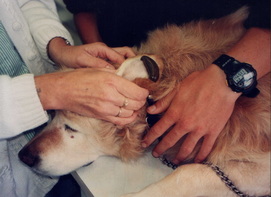Veterinary Leeches | What Can Leeches Be Used For? | Applying Leeches | Maintenance & Products | Downloads
An introduction to the veterinary use of leeches
Leeches have been used for centuries in human medicine and their successes are testament to their capabilities. It is therefore easy to consider how the leeches may also benefit animals.
Leeches contain many curative substances in their saliva and it is these which are so beneficial in the treatment of indications where blood flow needs to be encouraged or blood decongested. One of the main benefits of leech therapy is that the action of a leech cannot be matched by any modern method. Not only will a leech relieve the congested blood from an area whilst it is attached but the real benefit is continued long after the leech detaches, as the wound continues to bleed steadily for up to 10 hours. This therefore not only optimises the leeches' effectiveness, but it also means that the leech can be a very cost effective treatment.
Customers who use leeches often do so as it is a favourable option to that of putting the animal under anaesthetic, such as in cases of treating a hematoma on an old or pregnant animal.
To download our veterinary brochure click here.
Leeches contain many curative substances in their saliva and it is these which are so beneficial in the treatment of indications where blood flow needs to be encouraged or blood decongested. One of the main benefits of leech therapy is that the action of a leech cannot be matched by any modern method. Not only will a leech relieve the congested blood from an area whilst it is attached but the real benefit is continued long after the leech detaches, as the wound continues to bleed steadily for up to 10 hours. This therefore not only optimises the leeches' effectiveness, but it also means that the leech can be a very cost effective treatment.
Customers who use leeches often do so as it is a favourable option to that of putting the animal under anaesthetic, such as in cases of treating a hematoma on an old or pregnant animal.
To download our veterinary brochure click here.
How does a leech work?
Uniquely the leech has three jaws which are perfectly designed for sucking blood. Each jaw has approximately 100 teeth meaning that a leech bite consists of roughly 300 teeth.
Thankfully it is in fact pretty painless thanks to the anaesthetic which the leech releases into the wound when it bites. A major advantage of the tripartite arrangement of the jaws is that the leech bite produces a neat cut (resembling the Mercedes Benz emblem) that directly exposes the patient's underlying blood vessels.
The leech injects several compounds into the wound whilst it feeds, and it is these which ensure that the wound continues to bleed steadily for up to 10 hours. The leech first injects the compound known as hirudin, this is a powerful anti-thrombin and maintains blood flow as the leech feeds, and immediately after the leech has finished feeding.
Whilst the leech feeds it also injects a further compound known as calin and it is this which is responsible for the prolonged bleeding in the proceeding hours. Calin binds to collagen and subsequently neutralizes collagen's capacity to induce blood clotting. It is this continual flow of blood that can give valuable time to a body part or appendage to re-establish its own circulation, or to decrease the chances of blood congesting recurring.
Thankfully it is in fact pretty painless thanks to the anaesthetic which the leech releases into the wound when it bites. A major advantage of the tripartite arrangement of the jaws is that the leech bite produces a neat cut (resembling the Mercedes Benz emblem) that directly exposes the patient's underlying blood vessels.
The leech injects several compounds into the wound whilst it feeds, and it is these which ensure that the wound continues to bleed steadily for up to 10 hours. The leech first injects the compound known as hirudin, this is a powerful anti-thrombin and maintains blood flow as the leech feeds, and immediately after the leech has finished feeding.
Whilst the leech feeds it also injects a further compound known as calin and it is this which is responsible for the prolonged bleeding in the proceeding hours. Calin binds to collagen and subsequently neutralizes collagen's capacity to induce blood clotting. It is this continual flow of blood that can give valuable time to a body part or appendage to re-establish its own circulation, or to decrease the chances of blood congesting recurring.
Please note: that we only recommend the use of leeches to be carried out under veterinary
guidance as the animal’s welfare is our top priority.
If you require any further advice or assistance do not hesitate to contact us.
guidance as the animal’s welfare is our top priority.
If you require any further advice or assistance do not hesitate to contact us.

